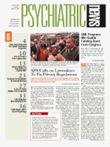The symptoms of inattention, hyperactivity, and impulsivity in children contribute to increased use of the medical system and increased costs, according to researchers who studied the financial burden of ADHD.
The results reported in the January 3 Journal of the American Medical Association (JAMA) show that over a nine-year period, the median medical costs for children with ADHD were $4,306 compared with $1,944 for children without ADHD.
Principal investigator Cynthia Leibson, Ph.D., told Psychiatric News, “My colleagues and I at the Mayo Clinic were surprised that the difference in medical costs was so great.” Leibson is an assistant professor in the department of health sciences research at the Mayo Clinic in Rochester, Minn.
What drives the costs up for children with ADHD are higher rates of admissions to hospital emergency and outpatient departments and visits to primary care physicians. The study excluded the costs of treatment by psychiatrists and mental health professionals.
Leibson and her colleagues began following 4,880 children in Rochester, Minn., with a median age of 7 years from 1987 through 1995. By the end of that period, the sample had decreased to 4,119. Of those children, 309 were classified as having ADHD based on a retrospective review of the children’s records by a trained professional in consultation with a developmental behavioral pediatrician.
The researchers further classified the ADHD cases as “definite” or “probable.” The criteria for a definite case were a clinical diagnosis and positive results from a parent or teacher questionnaire. A probable case had to meet only one of the two criteria, according to the authors.
When the authors excluded the probable cases of ADHD from their analysis, they found a similar significant difference in medical costs between the group with ADHD and the group without ADHD.
The researchers obtained the children’s medical and school records, which provided information about treatment, delivery settings, medical diagnoses, results of clinical and laboratory tests, and questionnaires completed by parents and teachers, among other items. To determine medical costs, the researchers reviewed patient data contained in an electronic billing system used by area hospitals.
“We found that children with ADHD had significantly higher rates of multiple medical conditions than the comparison group. These included major injuries, asthma, infections, and psychosocial problems,” according to Leibson.
This finding is consistent with several other reports showing that, compared with the general population, individuals with ADHD experience higher rates of psychosocial comorbidity, chronic health conditions, and adverse outcomes including substance abuse, poisoning, fractures, and automobile collisions, according to Leibson and her colleagues.
The authors acknowledged that the study has limitations. Among them is that costs for prescription drugs were excluded in addition to treatment costs for psychiatrists and mental health professionals. The authors believe that the impact of excluding outpatient drug costs was greater than excluding outpatient psychiatric treatment costs because only a small number of children with ADHD were seen by mental health professionals or psychiatrists in private practice.
Nonetheless, the findings have implications for individuals with ADHD, their parents, and health care providers, payers, and policymakers, said Leibson.
“Children and adolescents with ADHD and their parents and teachers should be aware of the increased likelihood of injuries and emergency room visits and remain alert to risky situations. Clinicians should look for conditions we found to be associated with ADHD,” said Leibson. “Policymakers, providers, and third-party payers need to ensure adequate access to medical care and delivery of services to meet the needs of patients and families affected by ADHD.”
She recommended that further research be done on cost-effective prevention measures and treatment of ADHD and related conditions.
An abstract of the study, “Use and Costs of Medical Care for Children and Adolescents With and Without Attention-Deficit/Hyperactivity Disorder” is posted on the Web at jama.ama-assn.org/issues/v285n1/abs/joc01336.html. ▪
